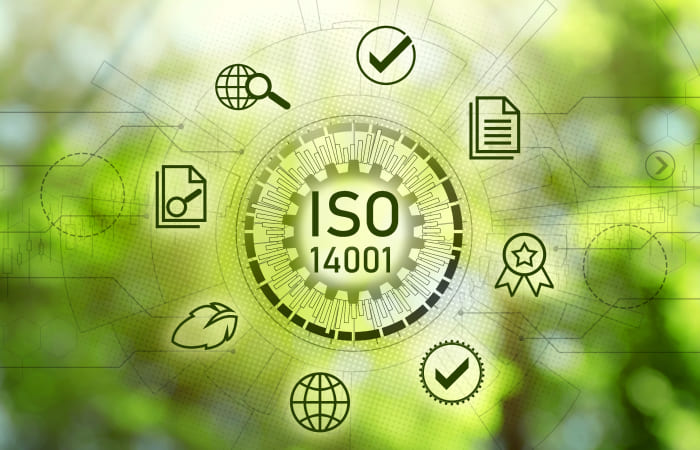
Understanding Hazard Analysis Critical Control Points (HACCP)
August 4, 2023
Understanding FSC: Forest Stewardship Council
August 4, 2023Introduction
In today’s world, which is changing incredibly quickly, ISO 14001, the widely accepted environmental management system standard, has become extremely important. This accreditation is a valuable tool for organisations looking to monitor and mitigate their environmental impacts as people and societies work to address environmental problems.
Understanding the significance of ISO 14001 standards in various industries becomes essential for promoting a greener and more responsible global economy with parallels to societal trends and the need for sustainability.
What Is ISO 14001 Standard?
ISO 14001 is an internationally acknowledged environmental management systems (EMS) standard. It provides a framework for organisations to establish, implement, maintain, and improve their environmental performance. The standard sets out the criteria for an effective EMS, helping organisations manage their environmental responsibilities systematically and consistently.
ISO 14001 was devised by the International Organisation for Standardisation (ISO) to address the growing concerns about environmental issues and the need for sustainable business practices. It applies to organisations of all types and sizes, regardless of the nature of their activities or the industry they belong to.
What Are The Challenges In Implementing ISO 14001?
Implementing ISO 14001 can come with certain challenges and obstacles. Addressing these challenges requires a multi-stakeholder approach, including government support, industry collaboration, and the active involvement of organisations and professionals in Malaysia.
By overcoming these challenges, organisations can successfully implement ISO 14001 and achieve improved environmental performance. Some of the main obstacles that organisations may encounter during the implementation process include:
- Lack of Awareness and Understanding
One of the primary obstacles is the need for more awareness and understanding of the ISO 14001 standard and its requirements. Many organisations may need to be more familiar with the standard or fully comprehend its benefits and implications.
- Resource Constraints
Implementing ISO 14001 requires dedicated resources, including financial resources, time, and personnel. Organisations may need help allocating the necessary resources, especially for smaller organisations or those with limited budgets.
- Lack of Internal Coordination
Implementing ISO 14001 requires collaboration and coordination across various organisational departments and levels. Inadequate communication and coordination can hinder the integration of environmental management practices and the successful implementation of the standard.
- Integration with Other Management Systems
Many organisations already have established management systems, such as Quality Management System (ISO 9001), Information Security Management System (ISO 27001) or Business Continuity Management System (ISO22301). Integrating ISO 14001 with existing systems can present integration challenges and require aligning different processes and objectives.
- Government Support and Infrastructure
Government support and infrastructure play a vital role in facilitating the implementation of ISO 14001. Organisations may face challenges with limited access to guidance materials, training programs, or regulatory enforcement. Close collaboration between government agencies, industry associations, and organisations can help overcome these challenges and create an enabling environment for ISO 14001 implementation.
- SME Participation
Small and medium-sized enterprises (SMEs) form a significant portion of the Malaysian business landscape. These organisations may face additional challenges due to limited resources, financial constraints, and a need for more expertise in environmental management. Providing tailored guidance and support to SMEs can help overcome these challenges and encourage wider adoption of ISO 14001.
- Access to Technical Expertise
Malaysia’s organisations may need help accessing specialised technical expertise, particularly in environmental impact assessment, pollution prevention, or waste management. Collaborating with environmental consultants or leveraging partnerships with industry associations and government agencies can help overcome these knowledge gaps.
- Supply Chain Management
Organisations that rely on extensive supply chains may need help ensuring that their suppliers adhere to environmental management practices. Encouraging supply chain partners to adopt ISO 14001 or similar standards can help address this challenge and ensure a more comprehensive approach to environmental management.
What Are The Benefits of ISO 14001 For Businesses?
Implementing ISO 14001 can bring several benefits to businesses. These benefits highlight the value of ISO 14001 for businesses, enabling them to improve their environmental performance, achieve compliance, enhance their reputation, and gain a competitive edge in the marketplace.
- Improved Environmental Performance
ISO 14001 helps businesses systematically manage their environmental impact, improving environmental performance. Organisations can reduce resource consumption, waste generation, and pollution by identifying and addressing environmental aspects and impacts, resulting in a more sustainable operation.
- Regulatory Subordination
ISO 14001 assists businesses in achieving compliance with environmental laws, regulations, and permits. By implementing the standard’s requirements, organisations can ensure they are aware of and meet the necessary environmental obligations, reducing the risk of legal penalties and reputational damage.
- Enhanced Reputation and Stakeholder Confidence
ISO 14001 certification demonstrates a business’s commitment to environmental responsibility and sustainable practices. It can enhance a company’s reputation and credibility, attracting environmentally conscious customers, investors, and other stakeholders who value sustainable business practices.
- Cost Savings
Implementing ISO 14001 often leads to cost savings through increased operational efficiency and resource optimisation. By identifying and addressing waste areas, businesses can reduce energy consumption, minimise raw material usage, and streamline processes, resulting in financial savings and improved profitability.
- Competitive Advantage
ISO 14001 certification can provide a competitive edge in the marketplace. Many customers and clients prefer to engage with environmentally responsible businesses. Certification can differentiate a company from its competitors, giving it a competitive advantage when bidding for contracts or securing new business opportunities.
- Risk Management
ISO 14001 helps businesses identify, assess, and manage environmental risks associated with their operations. By implementing proactive measures and controls, organisations can minimise the likelihood and impact of environmental incidents, such as pollution spills or non-compliance issues.
- Employee Engagement and Morale
ISO 14001 fosters a culture of environmental awareness and responsibility within an organisation. Engaging employees in environmental management initiatives can boost morale, improve job satisfaction, and enhance employee engagement. It also helps attract and retain talent, particularly among individuals who prioritise working for environmentally conscious organisations.
- Continuous Improvement
ISO 14001 emphasises the importance of continuous improvement in environmental performance. By establishing a framework for setting objectives, monitoring performance, and taking corrective actions, businesses can continually enhance their environmental management systems and practices, driving ongoing progress and innovation.
What Is The Difference Between ISO 14001 Standard and ISO 14001:2015?
ISO 14001:2015 is the latest version of the ISO 14001 standard, which replaced the previous version, ISO 14001:2004. The key differences between ISO 14001:2015 and the previous version lie in their structure, focus, and approach to environmental management.
It’s important to note that ISO 14001:2015 builds upon the foundation of ISO 14001:2004, with a stronger focus on strategic environmental management, leadership engagement, risk-based thinking, and stakeholder communication.
The transition from the previous version to ISO 14001:2015 permits associations to enhance their environmental management systems and align them with the current expectations and best practices in environmental sustainability.
Here are some of the notable differences:
| High-Level Structure (HLS) | ISO 14001:2015 follows the HLS, a standardised framework for management system standards. This structure aligns the requirements, definitions, and terms across various ISO management system standards, making it easier for organisations to integrate multiple management systems. |
| Context of the Organisation | ISO 14001:2015 emphasises a stronger understanding of the organisation’s context and environmental impact. Organisations must identify and consider external and internal factors, such as stakeholder expectations, industry trends, and environmental conditions, to establish an effective environmental management system. |
| Leadership and Commitment | The new standard highlights leadership involvement and commitment to environmental management. It requires top management to take accountability for the effectiveness of the environmental management system, provide leadership in integrating environmental considerations into the organisation’s overall strategy, and promote a culture of environmental responsibility. |
| Risk-Based Thinking | ISO 14001:2015 adopts a risk-based approach to environmental management. It requires organisations to identify and assess risks and opportunities related to environmental aspects and impacts. This approach helps organisations proactively manage risks, prevent incidents, and seize opportunities for improvement. |
| Lifecycle Perspective | ISO 14001:2015 encourages organisations to consider the entire lifecycle of their products or services when assessing environmental aspects and impacts. This includes raw material sourcing, product design, manufacturing, use, and end-of-life disposal. The lifecycle perspective facilitates a more comprehensive understanding of environmental impacts and enables organisations to identify opportunities for improvement throughout the value chain. |
| Communication and Documentation | The new standard emphasises the importance of internal and external communication regarding the organisation’s environmental performance and objectives. ISO 14001:2015 also allows more flexibility in documentation requirements, encouraging organisations to determine the necessary documentation based on their context, needs, and complexity. |
Summary
In conclusion, ISO 14001 is a widely recognised standard that provides organisations with a framework to establish, execute, sustain, and enhance their environmental management systems. By adhering to ISO 14001, businesses can systematically manage their environmental impact, achieve regulatory compliance, and enhance their environmental performance.
The standard promotes a culture of continuous improvement, fosters stakeholder confidence, and opens doors to new business opportunities. ISO 14001 enables organisations to demonstrate their commitment to environmental responsibility, gain a competitive advantage, and contribute to a more sustainable future.
Embracing ISO 14001 is a strategic decision that brings numerous benefits and positions organisations as responsible stewards of the environment. Should you require consultation or training on ISO 14001 in Malaysia, feel free to reach out to our ISO consultant and training provider.





